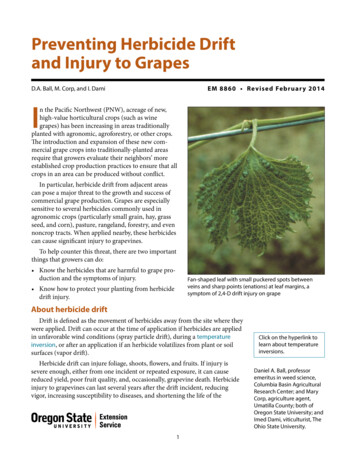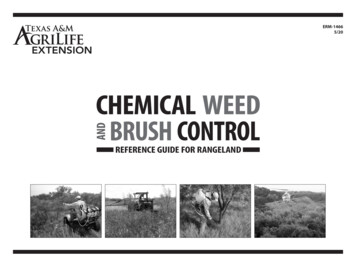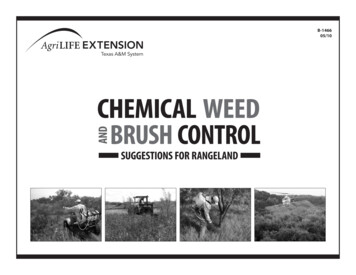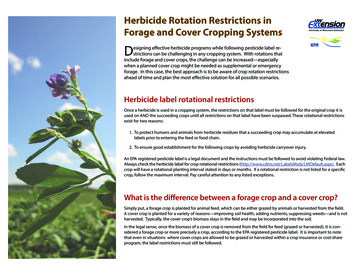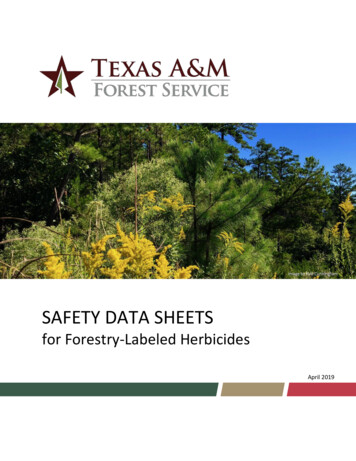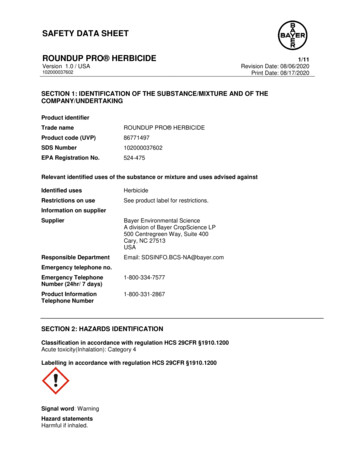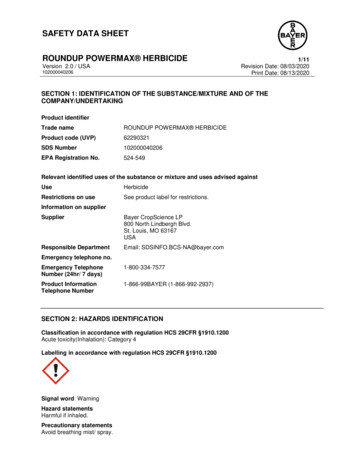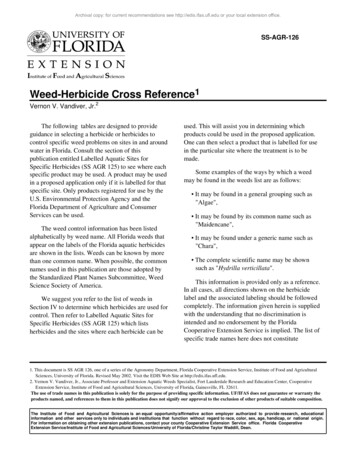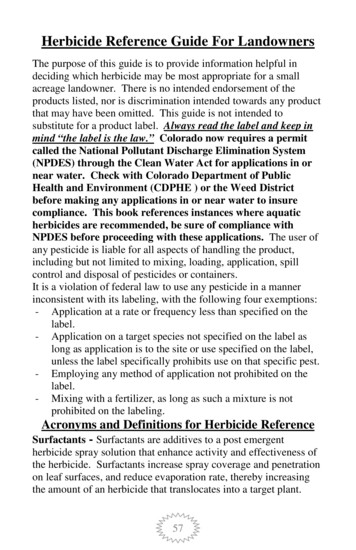
Transcription
Herbicide Reference Guide For LandownersThe purpose of this guide is to provide information helpful indeciding which herbicide may be most appropriate for a smallacreage landowner. There is no intended endorsement of theproducts listed, nor is discrimination intended towards any productthat may have been omitted. This guide is not intended tosubstitute for a product label. Always read the label and keep inmind “the label is the law.” Colorado now requires a permitcalled the National Pollutant Discharge Elimination System(NPDES) through the Clean Water Act for applications in ornear water. Check with Colorado Department of PublicHealth and Environment (CDPHE ) or the Weed Districtbefore making any applications in or near water to insurecompliance. This book references instances where aquaticherbicides are recommended, be sure of compliance withNPDES before proceeding with these applications. The user ofany pesticide is liable for all aspects of handling the product,including but not limited to mixing, loading, application, spillcontrol and disposal of pesticides or containers.It is a violation of federal law to use any pesticide in a mannerinconsistent with its labeling, with the following four exemptions:- Application at a rate or frequency less than specified on thelabel.- Application on a target species not specified on the label aslong as application is to the site or use specified on the label,unless the label specifically prohibits use on that specific pest.- Employing any method of application not prohibited on thelabel.- Mixing with a fertilizer, as long as such a mixture is notprohibited on the labeling.Acronyms and Definitions for Herbicide ReferenceSurfactants - Surfactants are additives to a post emergentherbicide spray solution that enhance activity and effectiveness ofthe herbicide. Surfactants increase spray coverage and penetrationon leaf surfaces, and reduce evaporation rate, thereby increasingthe amount of an herbicide that translocates into a target plant.57
A common question is whether a detergent soap will suffice as asurfactant or not. The best answer is to use the recommendedsurfactant designed to enhance the activity of a specific herbicide.When a user is investing time and money into a weed managementproject, why jeopardize success over such a minor cost.Surfactants recommended for the herbicides listed in this guide: COC - Crop oil concentrate is a petroleum oil based product,typically applied at a rate of 1 quart/acre, recommended foruse with imazapyr and triclopyr on cut-stump treatments. MSO - Methylated seed oil is a plant oil derivative, typicallyapplied at a rate of 1 quart/acre, for use with imazapic andquinclorac. Often used with other herbicides when appliedover weed species with very waxy or hairy leaves such ascommon mullein or Dalmatian toadflax. NIS - Nonionic surfactant is an organic compound usuallymixed in at 0.25 – 0.50 % volume per volume ratio forexample .25% v/v 1oz per 3 gal, for use with all otherherbicides listed in this guide. This surfactant is absolutelyessential for chlorsulfuron, metsulfuron methyl, andrimsulfuron to be effective.GUP – General Use Pesticide. Are products which are available tothe general public. All herbicides listed in this guide are generaluse unless otherwise specified.MSDS – Material Safety Data Sheet. A technical bulletin thatsupplements information found on the product label. This bulletinprovides detailed descriptions of a product’s physical propertiesand toxicity, and provides users and emergency personnel with theproper procedures for handling and working with that substance.Pesticide Label – A legal document located on the pesticidecontainer that provides information concerning the safe andeffective use of the pesticide. It is a violation of federal pesticidelaws to use any pesticide in a manner inconsistent with its labeling.58
PPE – Personal Protective Equipment (gloves, apron, eye safetyglasses, etc.). The required PPE for a specific compound is listedunder the “Hazards to Humans” section on the label. Always useprotective equipment specified on the label. The most serious riskof exposure from chemicals is during handling and mixingoperations with the concentrated product.Re-entry interval - Period of time immediately after a pesticideapplication when agricultural employees may not enter a pesticidetreated area without protective clothing.RUP – Restricted Use Pesticide. The "Restricted Use"classification restricts the purchase of a product, and its uses, to alicensed commercial, private, or public applicator.Landowners wishing to purchase and apply restricted usepesticides can obtain a Private Applicator’s License throughthe Colorado Department of Agriculture. Information isavailable at 303-239-4186 or eMain/CDAG/1178305424099Signal Words – Indicate the toxicity and/or hazards associatedwith the use of the pesticide. Pre-mix herbicides will always havethe highest toxicity level of the mixed active ingredients.- Caution – Category 3 or 4, least toxic. 1 ounce to 1pint swallowed lethal to an adult.- Warning – Category 2. 1 –3 teaspoons swallowedlethal to an adult.-Danger/Poison –Category 1, most toxic. 1-3drops swallowed lethal to an adult.Toxicity – Measured by LD50 (lethal dose, 50%), describes thedose of a pesticide that will kill ½ of a group of test animals from asingle dose. A pesticide with a lower LD50 is more toxic than onewith a higher number because it takes less of the pesticide to killhalf of the test animals.To obtain more comprehensive information regarding Coloradoand Federal pesticide laws and regulation, and an overview of theCSU Pesticide Safety Education Program, EP59
Herbicide IndexBrand nameAllyAmine 4ArsenalBanvelBrashChopperCimarronCimarron MaxCimarron wCurtailDistinctEcomazapyr 2Element 3AElement 4EscortFallowmasterForefrontFormula 40Garlon 3AGarlon 4GleanGrazonHabitatHardballHi-DepJourneyActive ingredientMetsulfuron methyl2,4-DImazapyrDicambaDicamba 2,4-DImazapyr adjuvantsMetsulfuron methylMetsulfuron methyl 2,4-D dicambaMetsulfuron methyl chlorsulfuronDicambaImazamoxImazapyr metsulfuronmethylClopyralid 2,4-DClopyralid triclopyrTriclopyr 2,4-DClopyralid 2,4-DDiflufenzopyr dicambaImazapyrTriclopyrTriclopyrMetsulfuron methylDicamba glyphosateAminopyralid 2,4-D2,4-DTriclopyrTriclopyrChlorsulfuronPicloram 2,4-DImazapyr2,4-D2,4-DGlyphosate ImazapicLandmarkChlorsulfuron sulfometuron methylLandmasterGlyphosate 2, trictedAquaticNo grazingPage #7378726666, 78727366, 73,7764, 73667072,7365, 7365, 7777, 7865, 78677277777366, 6963, 787877776474, 7672787869, 716469, 78
c 2,4-DOpensitelPlateauPowerlinePrescottPro 60 eran 720VistaWeedarWeed B GonWeedmasterAminopyralid metsulfuronmethylDicamba 2,4-DDiflufenzopyr dicambaImazapicQuincloracTriclopyr adjuvantsPicloram 2,4-DAminocyclopyrachlor chlorsulfuronImazapicImazapyrTriclopyr clopyralidMetsulfuron methylDicamba 2,4-DClopyralid zapyr diuronFluroxypyrDicambaChlorsulfuronImazapyr diuronPicloramClopyralidDicambaDicamba 2,4-DFluroxypyr2,4-DTriclopyrDicamba Pathfinder IIPathwayPerspectiveNo Grazing766371, 7863, 73RestrictedNo GrazingAquaticRestrictedRestrictedRestricted66, 786771757774, 7862, 64717265, 777366, 7865, 7776666969726866647274656666, 7868787766, 787861
AminocyclopyrachlorBrand Name:Perspective with ChlorsulfuronOther Pre-mixes:Streamline with metsulfuron methylViewpoint with metsulfuron methyl and imazapyrSignal word Rainfast Re-entry Hay harvest Grazing n4 hoursNANANADry formulation for use in: Non-cropland sites such as rights-of-way, industrial sites andfence rows. Range & pasture label pending – current label restrictslivestock grazing and haying for 1 year followingapplication.Environmental characteristics: Can be applied to water’s edge, do not apply directly towater. Not for use on irrigation ditchbanks. Active on target plants through foliar and root uptake. Applications to newly seeded grasses or under desirabletrees and shrubs may cause injury. The use of a nonionic surfactant, at a minimum rate of .25%volume/volume (1oz/3 gal), is essential. Perspective is a dry formulation that requires vigorousagitation to go into solution. For sprayer tanks that do notprovide agitation it is best to fill halfway with water, createslurry in a separate container (mix enough water and granulesto agitate until granules are totally dissolved) of the measuredherbicide, then add to tank to ensure the product goes intosolution.Primary target species: Perspective provides excellent control of the noxious weedspecies listed in this reference guide, with the exception ofany grass species. CSU / Larimer County Weed District field trials haveshown Perspective to be the most effective treatment forcontrol of leafy spurge and field bindweed.62
AminopyralidBrand Name:MilestonePre-mixes:Opensight with metsulfuron methylForefront with 2,4-DCapstone with triclopyrSignal rvalharvestinterval(days)(days)Caution2 hours12 hours00Liquid formulation, used in: Range & pasture, non-cropland sites such as rights-of-way.Environmental characteristics : Can be applied to water’s edge; do not apply directly towater. Active on target plants through foliar and root uptake. Not for use on irrigation ditchbanks. Caution under certain tree species. See Label.Primary target species : Canada thistle, biennial thistles, knapweeds, commonmullein, common teasel, oxeye daisy, sunflowers,cinquefoil, absinth wormwood, hawkweeds. (Plants ofcomposite, legume, and polygonum families). Not effective for controlling grass species, kochia,bindweed, leafy spurge, toadflax, houndstongue, or mostmustard species. Milestone is the most frequently recommended productfor control of Canada thistle and biennial thistles inrange and pasture.63
ChlorsulfuronBrand Name:Telar, GleanPre-mixes:Cimarron X-tra with metsulfuron methyl, Perspective withaminocyclopyrachlor, Landmark with sulfometuron methylSignal word Rainfast Re-entry Hay harvest Grazing n4 hours 4 hours0*0*Dry formulation used in: Range & pasture, non-crop and industrial sites.Environmental characteristics: Can be applied to water’s edge; not directly to water. Chlorsulfuron has soil residual activity and is active onweeds through foliar and root uptake. The use of a nonionic surfactant, at a minimum rate of.25% volume/volume (1oz/3 gal), is essential. Chlorsulfuron is a dry formulation that requires vigorousagitation to go into solution. For sprayer tanks that do notprovide agitation it is best to fill halfway with water, createslurry in a separate container (mix enough water andgranules to agitate until granules are totally dissolved) ofthe measured herbicide, then add to tank to ensure theproduct goes into solution.Primary target species: Mustard, biennial thistles, houndstongue, common mullein,common teasel, puncturevine (pre and post emergence),Dalmatian and yellow toadflax. Not effective for controlling most grass species, kochia,knapweed species, or bindweed. The pre-mix ‘Landmark’ provides excellent pre and postemergent control of cheatgrass and feral rye. Landmarkdoes not have a range & pasture label, treated areas cannotbe grazed or hayed for 1 year after application. Telar, applied at 2.0 oz product/acre with MSO,provides very effective control of Dalmatian toadflax.*Restriction dependant on rate of application64
ClopyralidBrand Name:Transline, Lontrel, StingerPre-mixes:Curtail, Cody with 2,4-DRedeem, Confront, Prescott with triclopyrSignal vest(days)0Grazinginterval(days)0Caution2 hours12 hoursLiquid formulation used in: Range & pasture, forest land, and rights-of-way. Cropland and turf.Environmental characteristics: Water soluble, should not be applied near water. Some soil activity but not as persistent as Tordon. Transline can be safely applied near trees and shrubs. Active on target plants primarily through foliar uptake,with root uptake to a lesser degree.Primary target species : Canada thistle, biennial thistles, knapweeds, commonteasel, oxeye daisy, sunflowers. Not effective for controlling grass species, kochia,bindweed, leafy spurge, toadflax, houndstongue, or mostmustard species. Safe to use over seedling grasses to control Canadathistle and other listed weed species on re-vegetationsites.65
DicambaBrand Name:Banvel, Clarity, Rifle, Sterling, VanquishPre-mixes:Brash, Outlaw, Rangestar, Veteran 720, Weedmaster with 2,4-DFallowmaster with glyphosateSignal word harvestinterval(days)(days)Caution4 hours24 hours37-70*0Liquid formulation used in: Range & pasture, crops, rights-of-way, and turf.Environmental characteristics: Water soluble, should not be applied near water. Active on target plants primarily through foliar uptake,with root uptake to a lesser degree. Do not apply near desirable trees and shrubs. Higher rates can cause injury to buffalograss. Dicamba is a volatile product that can damage off-targetvegetation through vapor drift. Do not use whentemperatures are expected to exceed 85 degrees Fahrenheitwithin 24 hours of application.Primary target species : Kochia and many other annual broadleaf species. At higherrates can be used for suppression of Canada thistle, fieldbindweed and biennial thistles. Not effective for controlling grass species. Dicamba is the most frequently recommended productused to selectively control kochia in establishedgrassland.*Restriction dependant on rate of application66
DiflufenzopyrBrand Name:Overdrive, Distinct – premixes with dicamba(Diflufenzopyr is not sold alone, available in a premix only)Signal vest(days)0Grazinginterval(days)0Caution4 hours12 hoursDry formulation used in: Range & pasture, rights-of-way, corn and fallowEnvironmental characteristics: Primarily absorbed through foliar applications, soil uptaketo a lesser degree. Use of surfactant recommended – nonionic or crop oilconcentrate Diflufenzopyr is a dry formulation that requires vigorousagitation to go into solution. For sprayer tanks that do notprovide agitation it is best to fill halfway with water, createslurry in a separate container (mix enough water andgranules to agitate until granules are totally dissolved) ofthe measured herbicide, then add to tank to ensure theproduct goes into solution.Primary target species: Kochia and many other annual broadleaf species. Athigher rates can be used for suppression of Canada thistle,field bindweed and biennial thistles. Not effective for controlling grass species. Overdrive is most often used in range and pasture tocomplement the activity of other herbicides such asaminocylopyrachlor, clopyralid, picloram, quinclorac andtriclopyr. Overdrive Paramount or Overdrive Perspectivetank mix provides very effective control of leafy spurge.67
FluroxypyrBrand Name:Vista, StaraneSignal vest(days)7Grazinginterval(days)0Warning1 hour12 hoursLiquid formulation used in: Non-cropland areas such as non-irrigation ditch banks,rights-of-way, industrial sites including grazed areas withinsites, small grains, corn and fallow.Environmental characteristics: Active on target plants through foliar uptake, no soilresidual activity. Not for use on irrigation ditchbanks.Primary target species : Kochia, prickly lettuce, puncturevine, sunflower and plantsof the nightshade family. Not effective for controlling grass species, Canada thistleor field bindweed. Safe to use over newly seeded grasses to control kochiaand other listed weed species on re-vegetation sites.68
GlyphosateBrand Name:Roundup, current brand names too numerous to listPre-mixes:Too numerous to list.Signal nHayharvest(days)NAGrazinginterval(days)NA1-44 hourshours*Liquid formulation used in: Crop, non-crop, fallow.Environmental characteristics **Non-selective herbicide (active on grasses and broadleafplants) that controls most annuals and perennials. Active through foliar uptake, has no soil activity. Usually surfactant is part of mix. Do not need to add extra. Labeled for use up to water’s edge. At least oneformulation, Rodeo, labeled for use in and around water.An aquatic non-ionic surfactant is needed.Primary target species: Effective for control of most grasses and broadleaf species. Selective control of winter annuals when applied at lowrates in the late winter or early spring when desirableperennial grasses are dormant.*Check product label.** Not approved for the Weed District cost-share program.69
ImazamoxBrand Name:Clearcast,Raptor – for use in alfalfa, dry bean, soybeans and other legumecropsSignal vest(days)NAGrazinginterval(days)NACaution2 hours4 hoursLabeled uses (sites): Clearcast is labeled for control of undesirable emergent andfloating aquatic vegetation in and around standing andflowing water. Applications may be made to controlundesirable wetland, riparian, and terrestrial vegetationgrowing in and around surface water including irrigationditchbanks, though some limitations and restrictions exist –SEE LABEL.Environmental characteristics : Can be applied in and around standing and flowing waterincluding irrigation ditchbanks. Active on target plants through foliar and root uptake. Choose a surfactant that is approved for aquatic use whenapplying in or near water. For terrestrial uses choose a non-ionic surfactant, MSO orcrop oil concentrate for best results.Primary target species : Cattails, purple loosestrife, ragweed species, whitetop andother mustard species. Perennial grasses and other desirable species such as sedgesand rushes may be suppressed. Degree of injury is ratedependant. Clearcast is very effective on cattails.70
ImazapicBrand Name:Plateau, PanoramicPre-mixes:Journey with glyphosateOasis with 2,4-DSignal vest(days)7Grazinginterval(days)0Caution1 hour12 hoursLiquid formulation used in: Range and pasture and rights-of-way.Environmental characteristics : Imazapic has soil residual activity, and is taken up in plantsthrough foliage and roots. This product has runoff potential and should not be usedon hillsides sloping toward water. Do not apply to water or inside irrigation ditches. Application timing, use rate and choice of surfactant canbe critical, read the label carefully. High rates can be injurious to cool season grasses suchas smooth brome.Primary target species: Leafy spurge, cheatgrass, mustard species, Dalmatiantoadflax, field bindweed, common teasel, houndstongue,Russian knapweed, suppression of thistle species at higherrates. Not effective on kochia or diffuse and spotted knapweed. Imazapic is the most commonly used herbicide forselective control of cheatgrass in newly seeded andestablished grass.71
ImazapyrBrand Name:Arsenal, Ecomazapyr 2, Habitat, PowerlinePre-mixes:Sahara, Topsite with diuron.Chopper – ready to use pre-mix with adjuvants for cut-stump orbasal bark treatments.Clearstand with metsulfuron methylSignal word harvestinterval(days)(days)Caution1 hourNANANALiquid formulation used in: Arsenal – Range and pasture (spot treatments), non-cropareas such as industrial sites, and rights-of-way. Habitat – Aquatic use - for control of undesirableemergent and floating aquatic vegetation in and aroundstanding and flowing water. Applications may be made tocontrol undesirable wetland, riparian, and terrestrialvegetation growing in and around surface water.Environmental characteristics : **Non-selective herbicide (controls grasses broadleafplants and brush). Persistent in soil, breaks down rapidly in water, uptake inplants through foliage and roots. Arsenal can be applied up to water’s edge. Habitat has anaquatic label – can be used in and around water. Not foruse on irrigation ditch banks.Primary target species: Often used in mixes for total vegetative control (parkinglots, industrial sites, etc.). Imazapyr is very effective for control of tamarisk,Russian olive and other woody species by foliarapplication or cut-stump treatments.72
Metsulfuron methylBrand Name:Ally, Cimarron, Escort, Pro 60 EG, MSM 60DFPre-mixes:Cimarron Max with dicamba and 2,4-DCimarron X-tra with chlorsulfuronOpensight with aminopyralidClearstand with imazapyrViewpoint with aminocyclpyrachlor and imazapyrStreamline with aminocyclopyrachlorSignal word Rainfast Re-entry Hay al (days)Caution4 hours4 hours0-3*0-3*Dry formulation used in: Range and pasture, rights-of-way, wheat, barley, and fallow.Environmental characteristics: Can be applied to water’s edge; do not apply directly towater or under desirable trees and shrubs. The use of a nonionic surfactant, at a minimum rate of .25%vol/vol (1 oz/3 gal), is essential effectiveness. Metsulfuron methyl is a dry formulation that requiresvigorous agitation to go into solution. For sprayer tanks thatdo not provide agitation it is best to fill halfway with water,create slurry in a separate container (mix enough water andgranules to agitate until granules are totally dissolved) of themeasured herbicide, then add to tank to ensure the productgoes into solution.Primary target species : Mustards such as hoary alyssum, hoary cress, perennialpepperweed, blue mustard, flixweed and tumblemustard. Effective for control of houndstongue, common mullein,common teasel, some brush species and assorted annualbroadleaf species. Not effective for controlling grass species, kochia, knapweedspecies or Canada thistle.*Restriction dependant on rate of application73
Picloram – *Restricted Use ProductBrand Name:Tordon, OutpostPre-mixes:Grazon, Pathway with 2,4-DSignal vest(days)14Grazinginterval(days)0Caution2 hours12 hoursLiquid formulation used in: Range and pasture, fallow cropland, and non-croplandareas.Environmental characteristics: This product is soluble in water and persistent in soil. Do not apply on ditchbanks or bottoms, near water, orunder desirable trees and shrubs. Tordon is residually active in the soil, and taken into a plantthrough foliar absorption and/or root uptake.Primary target species: Field bindweed, Canada thistle, biennial thistles,knapweeds, toadflax, leafy spurge, houndstongue, woodyspecies. Not effective for controlling kochia or most mustardspecies. Not effective for grass control, though will suppress certainestablished pasture grasses such as smooth brome.* Restricted Use Products for retail sale to and use only byCertified Applicators or persons under their direct supervision.See criteria in the preceding ‘definitions’ section page 59.74
QuincloracBrand Name:Paramount, Facet, DriveSignal vest(days)7Grazinginterval(days)0Caution6 hrs12 hoursDry or liquid formulation used in: Range & pasture, rice, sorghum, fallow and turf.Environmental characteristics: Can be applied to water’s edge. Do not apply directly towater or in areas where surface water is present. Quinclorac is active on target plants through foliar and rootuptake. Add methylated seed oil to tank mix at rate of 1 quart/acre Do not apply more than 16 oz/acre per calendar year. Quinclorac is a dry formulation that requires vigorousagitation to go into solution. For sprayer tanks that do notprovide agitation it is best to fill halfway with water, createslurry in a separate container (mix enough water andgranules to agitate until granules are totally dissolved) ofthe measured herbicide, then add to tank to ensure theproduct goes into solution.Primary target species: Leafy spurge, field bindweed, annual grasses such asbarnyardgrass, crabgrass, and green and yellow foxtail. Overdrive Paramount tankmix is one of the mosteffective treatments for control of leafy spurge.75
RimsulfuronSignal word(toxicity)Brand Name:Matrix, ys)NAGrazinginterval(days)NACaution4 hours4 hoursDry formulation used in: Agronomic crops and control of certain invasive species,such as cheatgrass and feral rye, in areas undergoingrestoration or re-vegetation. No range & pasture label – no livestock grazing orhaying for one year following application on rangelandor pasture.Environmental characteristics: Rimsulfuron is primarily active through foliar uptake, shortsoil residual activity for weed control. The use of a nonionic surfactant, at a minimum rate of.25% volume/volume (1oz/3 gal), is essential for thisproduct to be effective. Rimsulfuron is a dry formulation that requires vigorousagitation to go into solution. For sprayer tanks that do notprovide agitation it is best to fill halfway with water, createslurry in a separate container (mix enough water andgranules to agitate until granules are totally dissolved) ofthe measured herbicide, then add to tank to ensure theproduct goes into solution.Primary target species: Annual grasses such as cheatgrass and feral rye,puncturevine and plants of the mustard family. Rimsulfuron may be injurious to certain cool seasonperennial grasses such as western wheatgrass.76
TriclopyrBrand Name:Element 4, Element 3A, Garlon 4, Garlon 3A, Weed B Gon,CapstonePre-mixes:Redeem, Prescott with clopyralidCrossbow with 2,4-D.Capstone with aminopyralidPathfinder II – ready to use pre-mix with adjuvants necessary foreffective cut-stump or basal bark treatments.Many other pre-mix products are available.Signal wordRe-entryHay s)Caution –12 hours140Danger*Liquid formulation used in: Range and pasture, aquatic use (in and around water), noncropland, rights-of-way and turf.Environmental characteristics : Ester formulation can be volatile, and is best used whentemperature is not expected to exceed 85 degrees. Triclopyr has some soil activity but is primarily taken up byplants through foliage and/or vascular tissue (cut-stump orbasal bark treatment). Restrictions near water vary with formulation – Garlon 4 –up to water’s edge. Garlon 3A has an aquatic label, can beused to control target vegetation in standing water. Not for use on irrigation ditch banks.Primary target species: Used for controlling broadleaf weeds and woodyvegetation. Has little or no effect on grasses. Used as a cut-stump or basal bark treatment forcontrol of Russian olives, tamarisk, and other woodyspecies.*Signal word varies with differing triclopyr formulations77
2,4-DBrand Name:Amine 4, Formula 40, Hi-Dep, Weedar, Weedone, Hardball, andmany others too numerous to list.Pre-mixes:Too numerous to list.Signal rvalharvestinterval(days)(days)Danger –1 hour48 hours300Caution*Liquid formulation used in: A wide range of applications including range and pasture,crops, and non-cropland.Environmental characteristics : 2,4-D is the active ingredient in many compounds, and isavailable in ester, amine and acid formulations. Ester formulations are volatile and may injure non-targetplants through vapor drift. Low volatility (LV) esters areless susceptible to vapor drift, but may still volatilize attemperatures above 85 degrees. Amine formulationstypically do not volatilize, and should be used duringwarmer weather. Ester formulations penetrate foliage more readily, and areusually used at lower rates than amine formulations. An acid formulation, brand name – Hardball, is nonvolatileand labeled for aquatic and rangeland use. 2,4-D has little to no soil activity, uptake in plants isthrough foliage.Primary target species: Used for control of most broadleaf weeds. Higher rates forcontrol or suppression of perennials. Not effective for control of grasses, kochia or knapweedspecies.*Signal word varies with differing 2,4-D formulations78
Sprayer CalibrationIt is critical to know the output of a sprayer in order to be accuratein adding an herbicide to the tank.Handgun1.2.3.4.5.SprayVolume(GPA)Measure a calibration plot that is exactly 18.5 ft X 18.5ft (128th of an acre).Spray the plot uniformly with water, keeping thesprayer pressure constant. Note the number of secondsrequired.Spray into a bucket for the same number of seconds,again keeping the sprayer pressure constant.Measure the number of ounces of water in the bucket.Number of ounces of water measured from the bucketis equal to the number of gallons per acre (GPA) thesprayer is delivering.Amount of Herbicide to Add to Each Gallon of Waterin Ounces15Recommended Herbicide Rate/Acre (from label)1 oz4 oz7 oz1 Pint1 10.5140.025.1.1750.420.8350.02.08.140.330.632 tablespoons 6 teaspoons 1 fluid ounce 29.57 milliliters8 fluid ounces 1 cup; 2 cups 1 pint; 2 pints 1 quart;4 quarts 1 gallon; 1 gallon 128 fluid ounces1ounce (dry) 28.35 grams; 16 ounces 1 pound1 acre 43,560 square feet; 1 meter 3.281 feet1 gallon of water 8.3453 pounds of water79
Boom or Boomless Sprayer CalibrationVolume method1. On level ground, fill sprayer tank to a known level withwater and drift agent (if using).2. Turn on sprayer till all nozzles have output, shut
substitute for a product label. Always read the label and keep in . herbicide spray solution that enhance activity and effectiveness of the herbicide. Surfactants increase spray coverage and penetration . Hi-D
